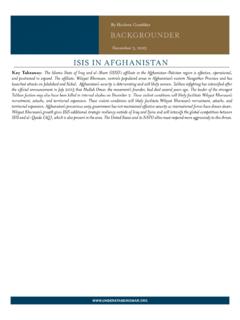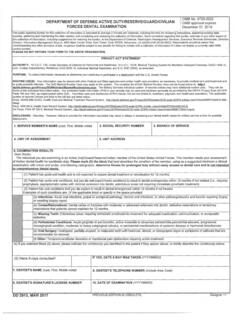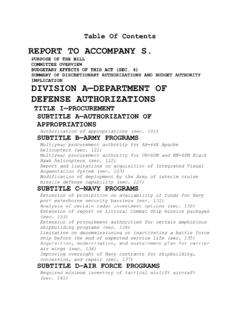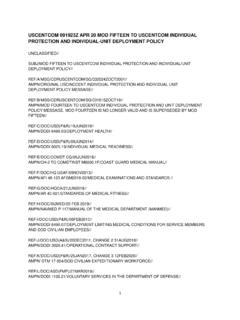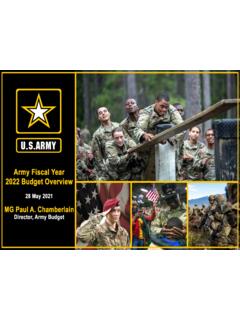Transcription of M C THE RUSSIAN MILITARY’S LESSONS LEARNED IN SYRIA
1 THE RUSSIAN MILITARY S LESSONS LEARNED IN SYRIAM ason ClarkJANUARY 2021 MILITARY LEARNING AND THE FUTURE OF WAR SERIESTHE RUSSIAN MILITARY S LESSONS LEARNED IN SYRIAM ason Clark, Institute for the Study of WarMILITARY LEARNING AND THE FUTURE OF WAR SERIESC over: DAGESTAN, RUSSIA - AUGUST 15, 2018: Vladimir Vasilyev, acting head of the Republic of Dagestan, Russia's Defense Minister Sergei Shoigu, Colonel General Alexander Dvornikov, commander of the RUSSIAN Army's Southern Military District, and RUSSIAN Deputy Defense Minister Dmitry Bulgakov (L-R) inspect the construction of the Caspian Flotilla's infrastructure in Kaspiysk.
2 Vadim Savitsky/ RUSSIAN Defence Ministry Press Office/TASS (Photo by Vadim Savitsky\TASS via Getty Images)All rights reserved. Printed in the United States of America. No part of this publication may be reproduced or transmitted in any form or by any means, electronic or mechanical, including photocopy, recording, or any information storage or retrieval system, without permission in writing or from the publisher. 2021 by the Institute for the Study of in 2021 in the United States of America by the Institute for the Study of 16th Street NW, Suite 515 | Washington, DC THE AUTHORM ason Clark is the Russia Team Lead and Research Analyst on the Russia and Ukraine portfolio at the Institute for the Study of War.
3 His work focuses on RUSSIAN military adaptation and learning in SYRIA . His work has been cited by Task & Purpose, Defense One, the Kyiv Post, the New York Times, and others. He has briefed multiple senior military and civilian decision makers on RUSSIAN military development and the Kremlin s global campaigns. Mason received a with Honors in International Studies with a focus on US Foreign Policy and RUSSIAN from American University s School of International Service. ACKNOWLEDGMENTS The author would like to thank the incredible team at ISW and the Critical Threats Project (CTP), without whom this report would not have been possible.
4 As always, enormous thanks to ISW President Kim Kagan and her invaluable help situating this report in the wider debate. The author is particularly grateful for the mentorship and analytical feedback of CTP Director Fred Kagan and ISW Non-resident National Security Research Fellow Nataliya Bugayova. National Security Fellow Jennifer Cafarella provided invaluable feedback on structure and the war in SYRIA . Special thanks to Russia Research Assistant George Barros for his analytical support. The author would like to thank John Dunford, Amy Kramer, and Jason Zhou for their feedback and suggestions during the writing of this report.
5 The work of former ISW interns Kayla Grose, Aidan Therrien, Aleksei Zimnitca, Michaela Walker, and Katie Flanagan contributed to the research and references in this report. ISW Russia intern Owen Lee made valuable contributions by compiling RUSSIAN writings on military learning. The author wishes to express great appreciation for the editing and production team, including Caitlin Forrest, Lisa Suchy, and Jacob Taylor. Last but not least, the author would like to thank former ISW Russia research assistants Catherine Harris and Jack Ulses for asking the author to read RUSSIAN military journals as an intern.
6 The author would not have come close to the insight of this report without their initial encouragement and THE INSTITUTEISW is a non-partisan and non-profit public policy research organization. It advances an informed under-standing of military affairs through reliable research, trusted analysis, and innovative education. It is committed to improving the nation s ability to execute military operations and respond to emerging threats in order to achieve the strategic objectives of the US around the RUSSIAN MILITARY S LESSONS LEARNED IN SYRIAISW and CTP believe that superior strategic insight derives from a fusion of traditional social science research and innovative technological methods.
7 ISW and CTP recognize that the analyst of the future must process a wide variety of information ranging from interviews and historical artifacts to high-volume struc-tured data. ISW and CTP thank their technology partners for their support in this innovative endeavor. Neo4j: Neo4j is a highly scalable native graph database that helps organizations build intelligent applications to meet evolving connected data challenges including fraud detection, tax evasion, situational awareness, real-time recommendations, master data management, network security, and information technology operations.
8 Global organizations like MITRE, Walmart, the World Economic Forum, UBS, Cisco, HP, Adidas, and Lufthansa rely on Neo4j to harness the connections in their : Ntrepid enables organizations to conduct their online activities safely. Ntrepid s Passages leverages the company s platform and fifteen-year history protecting the national security community from their most sophisticated global opponents. From corporate identity management to secure browsing, Ntrepid products facilitate online research and data collection and eliminate the threats that come with having a workforce connected to the : Linkurious provides graph visualization software that helps organizations detect and investigate insights hidden in graph data.
9 Linkurious supports government agencies and global companies in a range of applications from anti-money laundering and cyber-security to medical research. Linkurious makes complex connected data easy to understand for : Microsoft helps empower defense and intelligence agencies with its deep commitments to national security, trust, innovation, and compliance. With world-class security and a wide array of cloud services designed for mission success, the Microsoft Cloud offers a cloud platform designed for flexibility and scale to strengthen partnerships and alliances, create smart work environments and installations, and optimize operations to better meet mission needs and help foster a safer, more secure world.
10 Sayari: Sayari is a search company, not a traditional data vendor. They build search products that allow users to find corporate, financial, and public records in hard-target countries. Sayari products cover emerging, frontier, and offshore markets, and include corporate registries, official gazettes, litigation, vital records, customs data, and real property. They collect, structure, normalize, enrich, and index this data, often making it searchable for the very first time. BlackSky: BlackSky integrates a diverse set of sensors and data unparalleled in the industry to provide an unprecedented view of your world.




